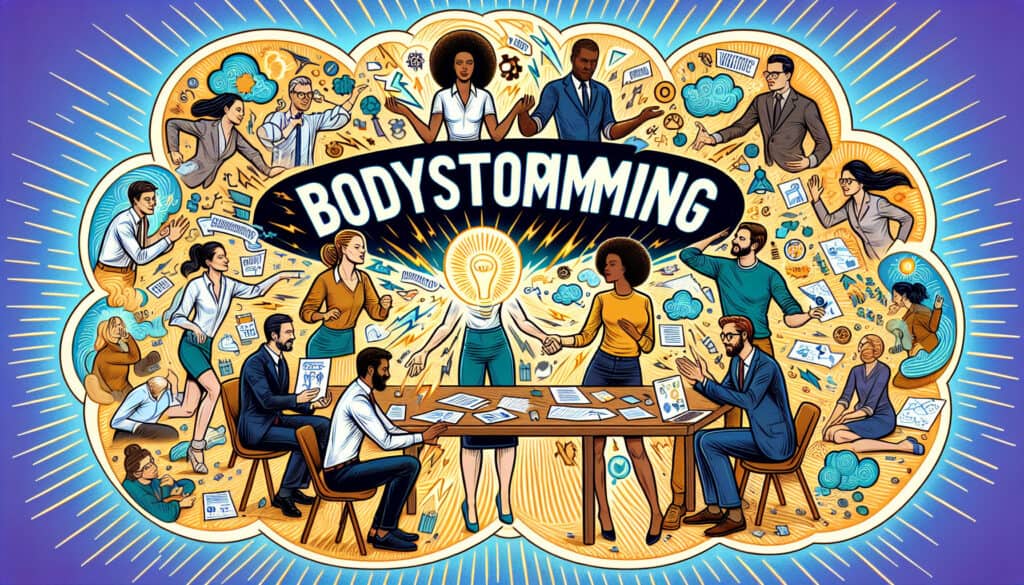A brainstorming technique that involves physically experiencing a situation to generate ideas.
- Methodologies: Customers & Marketing, Ideation, Product Design
Bodystorming

Bodystorming
- Brainstorming, Creativity, Design Thinking, Human-Centered Design, Ideation, Interaction Design, Prototyping, User experience (UX), User-Centered Design
Objective:
How it’s used:
- In bodystorming, participants act out a scenario to gain a deeper understanding of the user experience. This can help to generate more empathetic and user-centered ideas.
Pros
- Provides a rich and contextualized understanding of the user experience, can lead to more innovative and user-centered ideas, and can be a fun and engaging way to brainstorm.
Cons
- Can be difficult to set up, requires a willingness from participants to be physically active and to role-play, and may not be suitable for all types of problems.
Categories:
- Ideation, Product Design
Best for:
- Generating user-centered ideas by physically experiencing a situation.
Bodystorming can be particularly effective in industries such as healthcare, consumer electronics, and automotive design, where understanding user interactions with products or services is paramount. During this methodology, participants may include designers, engineers, marketing teams, and actual users or stakeholders, enriching the ideation process with diverse perspectives. This approach is especially beneficial during the ideation and prototyping phases of design projects, where conventional brainstorming might fall short in capturing the realism of physical interactions or emotional responses. For instance, when designing a new medical device, team members might simulate patient-doctor interactions to highlight potential obstacles in usability, thus allowing designers to address real-world concerns proactively. This methodology encourages playful experimentation, fostering an environment where team members feel comfortable exploring unconventional ideas without the constraints of traditional brainstorming methods. Engaging in bodystorming can also enhance team cohesion, as participants share experiences and insights that can lead to unexpected solutions, making it a valuable tool in the iterative design process. As teams physically immerse themselves in user situations, the tangible experience can spark innovative thoughts that may not surface through standard abstract brainstorming sessions.
Key steps of this methodology
- Identify a specific user scenario to explore.
- Assign roles to participants, ensuring diversity in perspectives.
- Act out the scenario, focusing on behaviors, emotions, and interactions.
- Encourage improvisation and spontaneous responses during the role-play.
- Observe the dynamics and take note of key interactions and reactions.
- Debrief immediately after the enactment to discuss experiences and observations.
- Brainstorm ideas and solutions based on insights gained from the enactment.
Pro Tips
- Encourage participants to adopt exaggerated physical movements and emotions to immerse themselves fully in the user's experience.
- Utilize props and environmental elements to simulate real-world interactions, enhancing authenticity in the scenarios.
- Incorporate targeted role-play scenarios that explore edge cases or unexpected user behaviors for deeper insights.
To read and compare several methodologies, we recommend the
> Extensive Methodologies Repository <
together with the 400+ other methodologies.
Your comments on this methodology or additional info are welcome on the comment section below ↓ , so as any engineering-related ideas or links.
Historical Context
1986
(if date is unknown or not relevant, e.g. "fluid mechanics", a rounded estimation of its notable emergence is provided)

Related Posts
METS to Calories Calculator
Meta-Analysis
Message Mapping
Mental Model Diagrams
Maximum Acceptable Pushing and Pulling Forces
Material Requirements Planning (MRP)